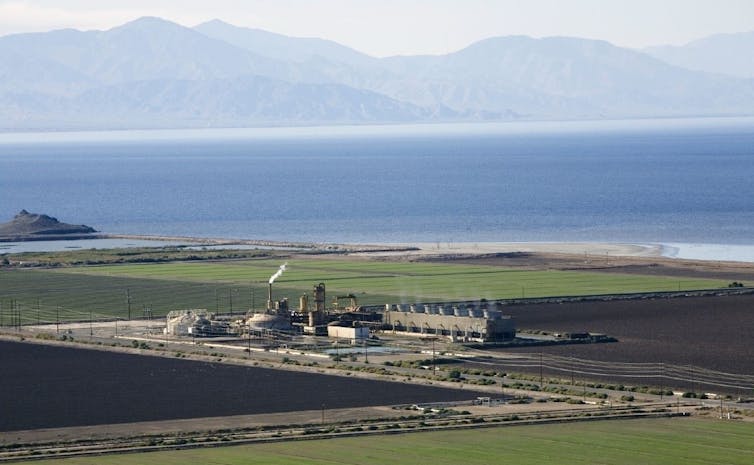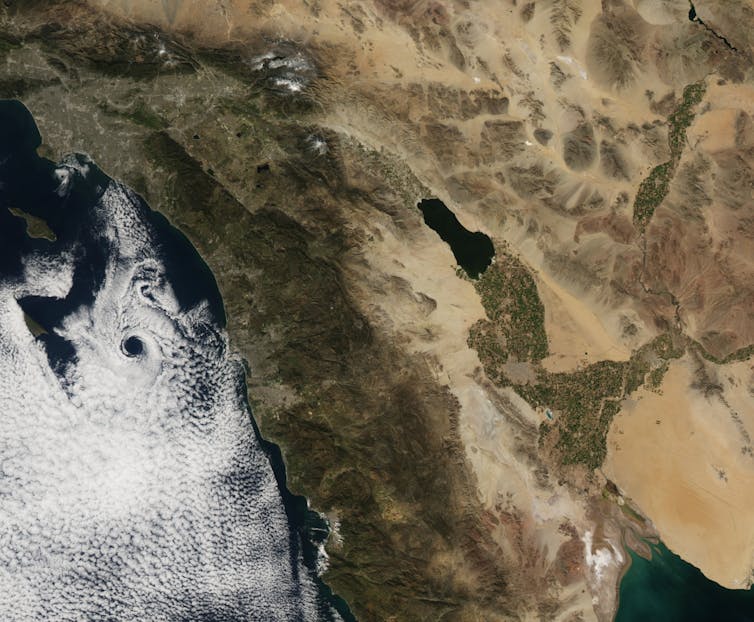How a few geothermal plants could solve America’s lithium supply crunch and boost the EV battery industry
Posted on 4 April 2022 by Guest Author
Bryant Jones, Ph.D. Candidate of Energy Policy, Boise State University and Michael McKibben, Research Professor of Geology, University of California, Riverside. This article is republished from The Conversation under a Creative Commons license. Read the original article.
 A pilot plant near the Salton Sea in California pairs lithium extraction with geothermal energy production. Michael McKibben Bryant Jones, Boise State University and Michael McKibben, University of California, Riverside
A pilot plant near the Salton Sea in California pairs lithium extraction with geothermal energy production. Michael McKibben Bryant Jones, Boise State University and Michael McKibben, University of California, Riverside
Geothermal energy has long been the forgotten member of the clean energy family, overshadowed by relatively cheap solar and wind power, despite its proven potential. But that may soon change – for an unexpected reason.
Geothermal technologies are on the verge of unlocking vast quantities of lithium from naturally occurring hot brines beneath places like California’s Salton Sea, a two-hour drive from San Diego.
Lithium is essential for lithium-ion batteries, which power electric vehicles and energy storage. Demand for these batteries is quickly rising, but the U.S. is currently heavily reliant on lithium imports from other countries – most of the nation’s lithium supply comes from Argentina, Chile, Russia and China. The ability to recover critical minerals from geothermal brines in the U.S. could have important implications for energy and mineral security, as well as global supply chains, workforce transitions and geopolitics.
As a geologist who works with geothermal brines and an energy policy scholar, we believe this technology can bolster the nation’s critical minerals supply chain at a time when concerns about the supply chain’s security are rising.
 The Elmore geothermal plant near the Salton Sea began operating in 1989. Berkshire Hathaway Energy
The Elmore geothermal plant near the Salton Sea began operating in 1989. Berkshire Hathaway Energy
Enough lithium to far exceed today’s US demand
Geothermal power plants use heat from the Earth to generate a constant supply of steam to run turbines that produce electricity. The plants operate by bringing up a complex saline solution located far underground, where it absorbs heat and is enriched with minerals such as lithium, manganese, zinc, potassium and boron.
Geothermal brines are the concentrated liquid left over after heat and steam are extracted at a geothermal plant. In the Salton Sea plants, these brines contain high concentrations – about 30% – of dissolved solids.
If test projects now underway prove that battery-grade lithium can be extracted from these brines cost effectively, 11 existing geothermal plants along the Salton Sea alone could have the potential to produce enough lithium metal to provide about 10 times the current U.S. demand.
How lithium is extracted during geothermal energy production. Courtesy of Controlled Thermal Resources.
Three geothermal operators at the Salton Sea geothermal field are in various stages of designing, constructing and testing pilot plants for direct lithium extraction from the hot brines.
At full production capacity, the 11 existing power plants near the Salton Sea, which currently generate about 432 megawatts of electricity, could also produce about 20,000 metric tons of lithium metal per year. The annual market value of this metal would be over $5 billion at current prices.
 The Salton Trough, seen from a satellite with the Salton Sea in the middle, is a rift valley that extends from east of Los Angeles, in the upper left, to the Gulf of California, visible at the bottom right. The San Andreas fault system crosses here, where two tectonic plates meet. Jesse Allen/NASA Earth Observatory
The Salton Trough, seen from a satellite with the Salton Sea in the middle, is a rift valley that extends from east of Los Angeles, in the upper left, to the Gulf of California, visible at the bottom right. The San Andreas fault system crosses here, where two tectonic plates meet. Jesse Allen/NASA Earth Observatory
Geopolitical risks in the lithium supply chain
Existing lithium supply chains are rife with uncertainties that put mineral security in question for the United States.
Russia’s war in Ukraine and competition with China, as well as close ties between Russia and China, underscore the geopolitical implications of the mineral-intensive clean energy transformation.
China is currently the leader in lithium processing and actively procures lithium reserves from other major producers. Chinese state mining operators often own mines in other countries, which produce other vital clean energy minerals like cobalt and nickel.
There is currently one lithium production facility in the U.S. That facility, in Nevada, extracts saline liquid and concentrates the lithium by allowing the water to evaporate in large, shallow ponds. In contrast, the process for extracting lithium while producing geothermal energy returns the water and brines to the earth. Adding another domestic source of lithium could improve energy and mineral security for the United States and its allies.
By pairing with geothermal power production, lithium extraction reduces the need for excess water consumption.
A lack of policy support
Geothermal power today represents less than 0.5% of the utility-scale electricity generation in the U.S.
One reason it remains a stagnant energy technology in the U.S. is the lack of strong policy support. Preliminary findings from a research study being conducted by one of us indicate that part of the problem is rooted in disagreements among older and newer geothermal companies themselves, including how they talk about geothermal energy’s benefits with policymakers, investors, the media and the public.
Geothermal power has the ability to complement solar and wind energy as a baseload power source – it is constant, unlike sunshine and wind – and to provide energy and mineral security. It could also offer a professional bridge for oil, gas and coal employees to transition into the clean energy economy.
The industry could benefit from policies like risk mitigation funds to lessen drilling exploration costs, grant programs to demonstrate innovations, long-term power contracts or tax incentives.
Adding the production of critical metals like lithium, manganese and zinc from geothermal brines could provide geothermal electrical power operators a new competitive advantage and help get geothermal onto the policy agenda.
Geothermal energy gets a boost in California
Trends might be moving in the right direction for geothermal energy producers.
In February, the California Public Utilities Commission adopted a new Preferred System Plan that encourages the state to develop 1,160 megawatts of new geothermal electricity. That’s on top of a 2021 decision to procure 1,000 megawatts from zero emissions, renewable, firm generating resources with an 80% capacity factor – which can only be met by geothermal technologies.
[Over 150,000 readers rely on The Conversation’s newsletters to understand the world. Sign up today.]
The California decisions were primarily meant to complement intermittent renewable energy, like solar and wind, and the retirement of the Diablo Canyon nuclear power plant. They suggest that the era of geothermal as the forgotten renewable energy may be ending.































 Arguments
Arguments






























Yup. Geothermal has been rather overlooked. Even this article doesn't really refer to the exciting new development of 'enhanced geothermal' and ultra-deep geothermal, both of which promise huge capacity available to almost all areas of the world, not just the current 'hot spots'
wiki article about some enhanced geothermal systems
It is very interesting to hear about echnologies that have dual applications. Here generating electricity and producing lithium. The amounts of lithium sound very large. We will have to see how their pilot plants work.
Nick Palmer, on that point we definitely agree, although I'd say that it is not that new. I have mentioned it several times over the years in various threads without arising much interest. Nonetheless, it remains one of the best options available. The small surface footprint, the 24-7 operation independent of weather, the lack of any waste product ending up in the environment, the lack of any kind of fuel needing to be extracted, exchanged and transported, the lack of risks of harmful by-products escaping, make a compelling argument in its favor. The plant in France drilled to 5000 meters, many locations would not require such deep drilling, but there is now technology that allows for even deeper wells. Of course, geology won't allow it to be done anywhere, but it should be done everywhere it can be. It's as close to a freebee as we can possibly find on our planet.
Last I read, the Soultz-sous-Forets plant was feeding 1.5 MW in the grid. Much knowledge and experience were gained in the development of what was intended to be a pilot experimental facility, that was later converted in a commercial electricity generation operation.
Philippe. Sorry I missed your mentioning this. It would have been nice to have seen someone else who sees the enormous potential for this. Possibly the greatest aspect is that it would even up the share of global energy supply that most nations would have because the newer techniques can access the energy almost everywhere on earth - no small set of nations would have a stranglehold on the supply of large amounts of energy
This potential source of lithium is great news, and I would be interested as to where else in the world the same might apply.
However, one point about geothermal. In order to properly complement low-cost low-impact variable sources like wind and solar, we don't need traditional (inflexible) "baseload" - that would merely compete with wind and solar for high merit-order grid slots and actually reduce the ability of the grid to be responsive. Instead, we need sources which can be ramped up and down easily and rapidly, to "fill the gaps" when solar and wind aren't able to fully meet demand. I can conceive of ways (high temperature heat storage, for example) that geothermal can be made somewhat flexible, but I'm wondering how much work has been done on this.
This is an important consideration as we shift to renewables-based grids in places where a substantial proportion of hydro isn't an option. As the IPCC AR6 WG3 TS states (box TS.9, p.55),:
"An increasing reliance on electricity from variable renewable sources,
notably wind and solar power, disrupts old concepts and makes many
existing guidelines obsolete for power system planning, e.g. that
specific generation types are needed for baseload, intermediate load and
peak load to follow and meet demand. In future power systems with high
shares of variable electricity from renewable sources, system planning
and markets will focus more on demand flexibility, grid infrastructure
and interconnections, storage on various timelines (on the minute,
hourly, overnight and seasonal scale), and increased coupling between
the energy sector and the building, transport and industrial sectors."
Meurig: Geothermal power is already very flexible, and appears quite suited to working with solar and wind power: "At the same time, geothermal power plants offer more flexibility than some other types of baseload power sources, as it is relatively easy to ramp their power production up and down depending on need."
www.rff.org/publications/explainers/geothermal-energy-101/
"It (geothermal power) can run as baseload power around the clock, including at night, or “load follow” to complement renewables’ fluctuations."
www.vox.com/energy-and-environment/2020/10/21/21515461/renewable-energy-geothermal-egs-ags-supercritical